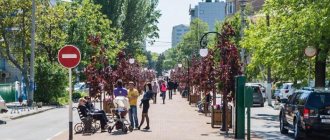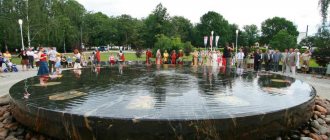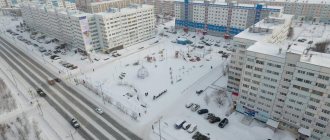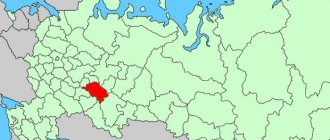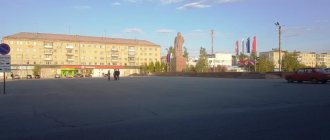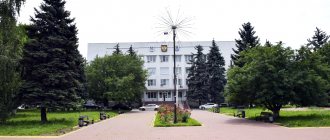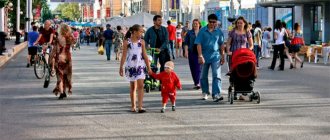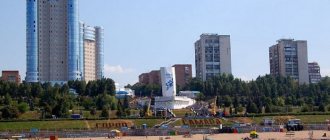The city of Leninogorsk, located in the southeast of Tatarstan, is one of the most beautiful, small, green settlements in the republic. It was founded along the Stepnoy Zai river at the end of the 18th century as the village of Novaya Pesmyanka, and only in 1955 it acquired the status of a city. A satellite map of Leninogorsk shows that it is surrounded by forests from the north, a bypass highway from the south and east, and a railway running through the forest from the west.
The city's population is 63 thousand people, most of whom are Russians and Tatars, the rest of the population are representatives of other nationalities. The map of Leninogorsk in the form of a diagram shows that the city is divided into three microdistricts, each of which has a well-developed infrastructure, there are educational institutions, cultural and leisure centers, shops and cafes. Leninogrsk has a lot of green spaces, which is why it is called the “green pearl” of Tatarstan.
The city is located on a hilly area, several rivers and streams flow through its territory, and there are also natural fresh water bodies, which can be seen on a detailed map of Leninogorsk. This is one of the few cities in Russia whose water supply comes only from natural springs with fresh water.
Location
The population of Leninogorsk has changed slightly in recent decades, remaining largely constant. The city is located in the upper reaches of the Stepnaya Zaina River. It is located on the slopes of the Bugulma-Shugurovsky plateau.
At the same time, its area is very small - about 24 and a half square meters. km. It is especially distinguished by the fact that throughout its history it has repeatedly been awarded the title of one of the most comfortable in the country. So we can definitely say that its residents are lucky in this regard.
Map
| Leninogorsk: maps |
Leninogorsk: photo from space (Google Maps) Leninogorsk: photo from space (Microsoft Virtual Earth)
| Leninogorsk. Nearest cities. Distances in km. on the map (in brackets along roads) + direction. Using the hyperlink in the distance , you can get the route (information courtesy of the AutoTransInfo website) | |||
| 1 | Bugulma | 21 (30) | IN |
| 2 | Lower Maktama | 29 (49) | WITH |
| 3 | Aktobe | 32 (73) | NE |
| 4 | Almetyevsk | 35 (42) | WITH |
| 5 | railway station Klyavlino (Samara region) | 46 (151) | SW |
| 6 | Aznakaevo | 47 (85) | NE |
| 7 | Jalil | 49 (75) | WITH |
| 8 | Northern (Orenburg region) | 55 (103) | YU |
| 9 | Bavly | 55 (68) | SE |
| 10 | Kamyshla (Samara region) | 57 (131) | YU |
| 11 | Cheremshan | 61 (152) | Z |
| 12 | Urussu | 63 (96) | IN |
| 13 | October | 66 (80) | IN |
| 14 | railway station Shentala (Samara region) | 67 (214) | Z |
| 15 | Sarmanovo | 73 (111) | WITH |
| 16 | Tuymazy | 79 (100) | Z |
| 17 | Isakly (Samara region) | 79 (181) | SW |
| 18 | Zainsk | 82 (99) | WITH |
| 19 | Subkhankulovo (Republic of Bashkortostan) | 86 (108) | IN |
| 20 | Serafimovsky (Republic of Bashkortostan) | 87 (99) | IN |
| 21 | Muslyumovo | 90 (112) | NE |
| 22 | Chelno-Vershiny (Samara region) | 91 (239) | Z |
| 23 | Novosheshminsk | 94 (144) | NW |
| 24 | Ermekeyevo (Republic of Bashkortostan) | 96 (151) | SE |
| 25 | Sharan (Republic of Bashkortostan) | 102 (128) | IN |
| 26 | Kandra (Republic of Bashkortostan) | 106 (127) | IN |
| 27 | Bakaly (Republic of Bashkortostan) | 106 (175) | NE |
| 28 | Pokhvistnevo | 107 (179) | YU |
| 29 | Buguruslan | 109 (160) | YU |
| 30 | Nurlat | 109 (190) | Z |
a brief description of
Located on the slopes of the Bugulma-Belebeevskaya Upland, 322 km southeast of Kazan. Railway Pismyanka station.
Territory (sq. km): 31
Information about the city of Leninogorsk on the Russian Wikipedia site
Historical sketch
It emerged as a working settlement on the site of the village of Novaya Pismyanka (Tatar Yana-Pismen) in connection with the discovery and development of the Romashkinskoye oil field in 1948. City of Leninogorsk since 1955
In the 19th century settlement Novopismyanskaya, also known as Novaya Pismyanka, apparently separated from the village of Pismyanskaya Staraya, also known as Pismyanskaya Yasachnaya. The common element of these names, Pismyanka, is a Russian adaptation of the Tatra toponymic basis pismen, pechmen, widely represented in the names of rivers and villages of Tatarstan. This basis is traced back to the ancient Turkic bishe “forest, grove,” and the element men is compared with the ending in the ethnonyms Turkmen, buserman.
Economy
Leninogorsk is one of the centers of oil and gas production.
, automation. Production of building materials.
Main enterprises
OIL PRODUCTION INDUSTRY
NGDU "Leninogorskneft" OJSC "Tatneft"
423270, Republic of Tatarstan, Leninogorsk district, Leninogorsk, st.
Leningradskaya, 8 Offers:
oil
Experimental Department "Tatneftebitum" OJSC "Tatneft"
423270, Republic of Tatarstan, Leninogorsk district, Leninogorsk, st.
Tchaikovsky, 2 Offers:
oil
Culture, science, education
Branch of the Academy of Oil and Gas.
Museum of the History of Tatar Oil.
Showroom.
Universities of the city
Leninogorsk branch of Kazan State Technical University named after.
A.N. Tupolev 423250, Republic of Tatarstan, Leninogorsk district, Leninogorsk, st. Zavaarykina, 2
Museums, galleries, exhibition halls
Leninogorsk Museum of Local Lore 423250, Republic of Tatarstan, Leninogorsk district, Leninogorsk, st. Shashina, 18 Phone(s): (85595) 5-05-91
| Population by year (thousands of inhabitants) | |||||||
| 1939 | 2.3 | 1989 | 62.1 | 2006 | 65.5 | 2015 | 63.6 |
| 1959 | 38.6 | 1992 | 64.1 | 2007 | 65.7 | 2016 | 63.3 |
| 1967 | 42 | 1996 | 67.1 | 2008 | 65.8 | 2017 | 63.0 |
| 1970 | 46.6 | 1998 | 67.9 | 2010 | 65.5 | 2018 | 62.5 |
| 1976 | 51 | 2000 | 68.1 | 2011 | 64.1 | 2019 | 62.0 |
| 1979 | 53.6 | 2001 | 68.2 | 2012 | 63.7 | 2020 | 61.7 |
| 1982 | 57 | 2003 | 65.6 | 2013 | 63.9 | 2021 | 61.3 |
| 1986 | 60 | 2005 | 65.6 | 2014 | 63.7 | ||
Story
The first settlements in the area of the future Leninogorsk in Tatarstan arose in the 30s of the 18th century. The ancestor of the city is officially considered to be Pismyanskaya Sloboda, which later became known as Yasachinskaya Pismyanka, and over time, Staraya Pismyanka. It was one of the largest settlements in these places. Just five years after its founding, there were more than 100 households and more than seven hundred adult residents.
Soon people felt crowded here; nearby they founded the village of Novaya Pismyanka, which eventually became Leninogorsk in Tatarstan. This happened in 1795. New Pismyanka grew very quickly, which was due to demographic, social and economic reasons. In 1859, a church was built here, and the settlement received the status of a village. In 1883, the center of the volost moved here. By this time, the population of Leninogorsk was almost one and a half thousand inhabitants.
By the outbreak of the First World War it was one of the largest population centers in the entire region. About two thousand people lived in almost 400 households.
XX century
Soviet power was established here quite early. After the Bolshevik victory, rural and volost deputies were quickly elected here.
In 1930, as part of collectivization, the first collective farm was organized, which was named “13 Years of October”; soon after this, Novaya Pismyanka became part of the Bugulminsky district. In 1935, it became the center of the district of the same name.
On June 22, 1941, when it became known about the Nazi attack on the Soviet Union, numerous rallies of workers were held in the village. A large number of volunteers went to the front. By the middle of 1941, more than a thousand people from Novaya Pismyanka alone had gone to war. 12 residents of Leninogorsk became Heroes of the Soviet Union, many died without returning home.
After the war, active development of industrial enterprises began here. In 1947, they began drilling an oil well, and a large Romashkinskoye field was discovered in these places. Since 1950, the Tatburneft drilling trust has been operating here, and the Bugulmaneft oil production trust has been created. A tower assembly office, a tractor office, and housing and communal services offices were organized.
Large-scale construction of the first oil workers' settlement began, which was named Zelenogorsk. The work was carried out by a construction and installation trust created specifically for this purpose in the workers’ village, and units of the Soviet army assisted in this. Over the course of several years, more than 100 thousand square meters of housing, a school, a club, a fire station, a bakery and even a hospital campus were put into operation here.
City status
In 1955, the workers' settlement of Novaya Pismyanka was officially given the status of a city and was renamed Leninogorsk.
At the end of the 60s, a decision was made to create new enterprises that could employ new residents of the city. A garment factory, an aggregate-mechanical plant, and another oil field appeared here. Capital housing construction is developing rapidly, and a large number of four-story residential buildings are appearing in the city. The capacity of the reinforced concrete products plant is increased, and a plant for the production of asphalt and bricks appears.
The master plan adopted by the authorities in the 70s becomes a new stage in urban planning. A full-scale reconstruction of Tukay, Leningradskaya, Sverdlov streets and Lenin Avenue is being carried out. Projects for planning new microdistricts are appearing, which attracts a large number of new residents.
Attractions
Monument to the discoverers of oil in Tatarstan - the monument project was jointly developed by the architect A. Pecherkin and sculptor B. N. Fuzeev and was inaugurated in September 1975 at the intersection of Lenin and 50 Years of Victory Avenues (Sverdlova Street). The monument itself is a 33-meter-high oil fountain, made of stainless steel, bursting out of the ground, surrounded by a ring of sculptural relief with a diameter of 18 meters and a height of 2.5 meters. This gigantic ring rests on powerful pylons lined with marble. Organically combining high symbolism and historical narrative, this structure fully reveals the significance of such an event as the beginning of oil production in Tatarstan. The monument to V.D. Shashin was inaugurated in 1981 for the outstanding contribution of Valentin Dmitrievich Shashin to the development of the oil industry of Tatarstan. The monument is located on Shashina Avenue and st. Moryakova.
Alley of Heroes - a memorial complex was inaugurated by Hero of the Soviet Union Samat Salakhovich Sadriev in 1970 along 50 Let Pobedy Avenue (Sverdlova Street) as a sign of sincere gratitude and eternal memory of the heroism of those who contributed their grain to the scales of victory in the Great Patriotic War. Nowadays on the territory of the memorial there is a monument to the fallen (1970), an Eternal Flame (1970), 12 obelisks with busts of Heroes of the Soviet Union (1998), an Obelisk of Glory (2002), a bas-relief to three full holders of the Order of Glory (2010)], a bas-relief to home front workers (2011) ), bas-relief perpetuating the memory of the fallen (2011).
Monument to V.I. Lenin - the grand opening of the monument took place in 1960 on the central square named after. Lenin.[40] The sculpture depicts V.I. Lenin at the moment of his speech, his right hand is addressed to the people in a decisive appeal. The monument “Calling Leader” was created by sculptor G. D. Alekseev, who was lucky enough to capture the unforgettable image of Lenin directly from life. The sculpture, which became famous in 1924 by the government commission for perpetuating the memory of Lenin, was approved for wide “reproduction and distribution” in many cities of the Union,[131] and one of them was installed in Leninogorsk.
Alley of Honored Oil Workers - a memorial complex was opened in 2002 along 50 Let Pobedy Avenue. On the territory of the memorial there is a fountain and 22 bas-reliefs with the names and portraits of those thanks to whom the oil industry was created and developed not only in the city and the republic, but also in the entire country as a whole.
Monument to M. Vakhitov - the opening of the monument took place in 1970 at the intersection of Lenin Ave. and st. Kutuzova. The monument is a bust of the Tatar revolutionary and social and political figure Mullanur Vakhitov installed on a pedestal; a small park is located near the monument.
Monument to G. Tukay - the grand opening of the monument took place in 2000 at the intersection of Lenin Ave. and st. Tukaya. The monument is a bust of the famous Tatar poet, literary critic, publicist, public figure and translator Gabdulla Tukay, mounted on a pedestal.
Monument “Time” - the opening of the monument took place in 1998 at the roundabout of the streets: Naberezhnaya, Druzhba Narodov, Promyslova, Pervomaiskaya. The monument depicts a clock mechanism and was installed on the site of the first tents of oil workers who gave birth to the city. Rotunda-stele dedicated to the first building of the city - the opening of the rotunda took place in 1955 on the territory of the park of culture and recreation named after. M. Gorky in honor of the founding of the city.
Black rotunda - the opening of the rotunda took place in 2005 on the territory of the park of culture and recreation named after. M. Gorky in honor of the fiftieth anniversary of the city.
Monument to M. Gorky - the monument was installed in the park of culture and recreation named after. M. Gorky. The monument to the Russian writer, prose writer and playwright, erected on a pedestal, depicts Maxim Gorky during a walk in the park.
Monument to the liquidators of the Chernobyl accident - the grand opening of the monument took place in November 2011. The initiator of the installation of the monument was the All-Russian public organization Chernobyl Union. In total, 190 Leninogorsk residents were sent to eliminate the consequences of the accident at the Chernobyl nuclear power plant and other radiation and environmental disasters, 69 of whom were awarded state awards.
Monument to participants in local conflicts - the grand opening of the monument took place in November 2011. The initiator of the installation of the monument was the public organization “Combat Brotherhood”. In total, 720 Leninogorsk residents performed military service in hot spots, 63 of whom were awarded state awards
Modern period
After the collapse of the Soviet Union, the socio-economic situation in the country changed dramatically. Many large industrial enterprises found themselves on the verge of bankruptcy, and the situation in Tatarstan itself was not easy. In Leninogorsk, the aggregate-mechanical plant was closed, about four and a half thousand people found themselves without work.
But even despite such a difficult economic situation, with the support of Tatneft, new enterprises were opened, as well as social facilities. For example, Lyceum No. 12, agricultural park.
Population
The first data on the population of Leninogorsk dates back to 1864, when the settlement was still a workers' village. At that time, almost one and a half thousand people lived in it. In 1890, a little more than two thousand inhabitants officially lived here.
In Soviet times, when oil production appeared here, the population of Leninogorsk increased many times over. In 1959, almost 39 thousand inhabitants lived here. The city passed the 50 thousand inhabitants mark in 1976. During perestroika, about 62 thousand residents lived in Leninogorsk, Leninogorsk district. In the 90s, when there was crisis and devastation in the country, the oil industry remained one of the most in demand in the country, so in Leningorsk, even at that time, the population did not decrease, but gradually increased.
In 2007, the maximum number of residents lived here - 65,751 people. After this and until now, the population of Leninogorsk has decreased slightly, but only slightly. Currently, 63,049 people live here. The dynamics have remained negative in recent years. In recent years, the number of residents of Leninogorsk has mainly declined due to negative natural growth and migration. The birth rate in the city is approximately 10-11%, and the death rate is 14-15%. Every year 4-5% fewer people are born than die.
The population density of Leninogorsk is about two and a half thousand people per square kilometer. Compared to the Republic of Tatarstan, this is an extremely low figure, since in the region it is twice as high. But it is worth noting that this figure was mainly achieved due to the million-plus city of Kazan, while in the rest of Tatarstan the density is still lower.
According to local authorities, by 2030 the population will decrease to 62.5 thousand people.
Map of Leninogorsk with streets
Among the streets of Leninogorsk, 2 are main ones: Bugulminskaya and Tchaikovskogo. They connect in the city center and divide it into 2 parts. Anyone who has ever visited Leninogorsk was probably fascinated by the beauty and amenities of the settlement. On the map of Leninogorsk by district you can find many neat parks and squares, galleries, and museums.
In total, there are 152 streets in the city, the outline of which on the map is mainly rectangular. Transport links are provided by city buses. The main road routes of Leninogorsk are easy to identify on the city map. You can also consider the intersections of streets, determine their length and direction of traffic lanes.
Leninogorsk is connected with other cities of the republic by suburban road transport and a railway, which, as the map of Leninogorsk with streets shows, runs along the southwestern outskirts of the settlement. The railway station was built a year after the settlement was given city status; before that, the population was served by the Pesmyanka station.
Republican highways connect the city with Kazan (308 km), Ufa (250 km), Magnitogorsk (585 km) and other large cities in neighboring regions.
Age composition
Leninogorsk is home to 1.62% of the population of all republics, including 2.2% of the urban population of Tatarstan.
Almost 17% of local residents are teenagers under the age of 16, the working-age population is almost 64%, and the city has 19.2% pensioners.
In total, more than 25 nationalities live in Leninogorsk. Two are predominant - Russians (43.3%) and Tatars (42.8%). The most popular religions in the city—Orthodoxy and Islam, respectively—are in the same ratio. Also in the region there are just over 5% Mordovians and Chuvashs.
Leninogorsk
(Republic of Tatarstan)
OKATO code:
92425
Founded:
1948
City since:
1955 City of district subordination (Leninogorsk district of the Republic of Tatarstan)
Center:
Leninogorsk district
Telephone code (reference phone)
| 85515***** | 20-9-40 |
Deviation from Moscow time, hours:
0
Geographic latitude:
54°36′
Geographic longitude:
52°28′
Altitude above sea level, meters:
230 Sunrise and sunset times of the Sun and Moon in the city of Leninogorsk
How much do Leninogorsk residents earn?
Despite the fact that the oil industry is developed here, the standard of living in Leninogorsk is relatively low. The average salary in the city is 18,703 rubles.
But it is worth considering that the cost of food, a square meter of housing and apartment rentals are significantly lower than in the capitals and even Kazan itself, which is the center of Tatarstan. At the same time, wages for workers employed at oil refineries remain quite high.
The unemployment rate is about 1 percent of the economically active population. The Leninogorsk Employment Center is trying to correct this situation. Anyone can go there at 51 Gagarin Street.
In the city, the majority of the working population have higher and secondary education, which ensures such a low unemployment rate.

